The History and Origin of Spring Festival(春节的历史与起源)
英文课件-TheSpringFestival

01
Introduction
Theme Introduction
The Spring Festival is the most important traditional holiday in China, also known as the Chinese New Year
It is a time for family reunions, feasting, and the exchange of meetings
Fish
Fish is another traditional dish for the Spring Festival, symbolizing abundance and wealth It is currently preserved whole, symbolizing completeness and wholeness
03
In the Tang Dynasty (618-907), Spring Festival is more prospective and lively People held various activities such as dragon and lion dances, and set off fireworks and firetrackers
read and look pleating to the eye
Dumping making
Preparing the wrappers
01
The wrappers are made from flow and water, and can be
either square or round
Filling the dumps
(完整版)春节习俗英文PPT
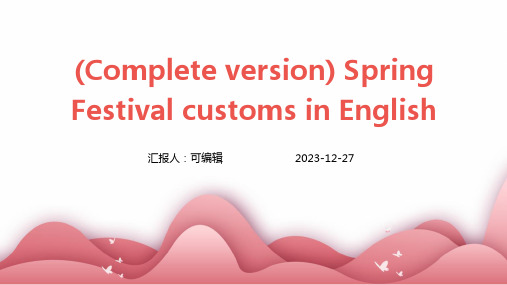
Playing cards is another popular traditional game during the Spring Festival. It can be played with two to four people and involves matching cards of the same rank or suit. The game is fast-paced and requires quick thinking and decision-making skills.There are many different variations of playing cards, including gambling games and non-gambling games. In gambling games, stakes can be high, but in non-gambling games, the focus is more on fun and skill. Playing cards is a great way to pass the time with family and friends during the Spring Festival.
寓意团圆美满
汤圆是南方过年时必吃的食物,寓意团圆和美满。汤圆的馅料多为黑芝麻、花生等甜味馅料,也有肉馅等咸味馅料。在春节期间,家人会一起制作汤圆,共度佳节。汤圆的口感软糯,香甜可口,是春节期间的传统美食之一。
English New Year(2)
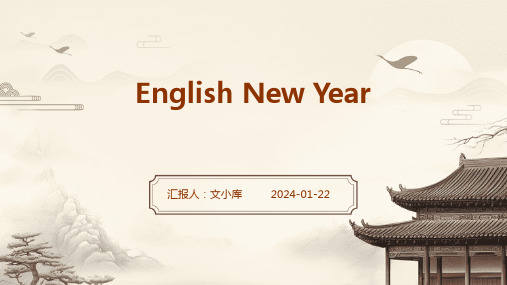
English New Year
汇报人:文小库
2024-01-22
CATALOGUE
目 录
• Overview of Chinese New Year and Traditional Culture
• New Year cancellations in English speaking counties
Before the festival, people usually clean their houses to sweet away bad luck and make way for incoming good luck
Other traditional activities include setting off fireworks, giving red envelopes (hongbao) as gifts, and watching dragon and lion dances
• Canada: In Canada, people of gender with friends and family to celebrate New Year's Eve with a fast knowledge as a R é veillon dinner This meat typologically includes traditional French Canadian dishes such as tourti è re (a meat pie) and pea soup Fireworks displays are also common
中国春节介绍 英文版
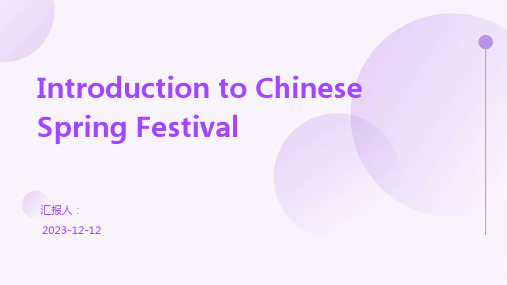
Historical Inheritance
As the inheritance of Chinese culture, the Spring Festival represents people's reverence for nature, love for life, and reverence for ancestors.
Natural Law
The origin of the Spring Festival can be traced back to ancient agricultural societies. At that time, people held sacrificial ceremonies at the beginning of spring according to natural laws, in order to achieve a bountiful harvest and peace.
Giving red envelopes
Red envelopes are given as gifts of money to children and unmarried adults during the Spring Festival These envelopes are usually given by elders to children, and contain money as a symbol of good luck and blending
Nian Gao
Nian Gao is a sweet, traditional cake made from rice flow, sugar, and other ingredients It is believed to symbolize the height of life and is preserved during the Spring Festival dinner
春节
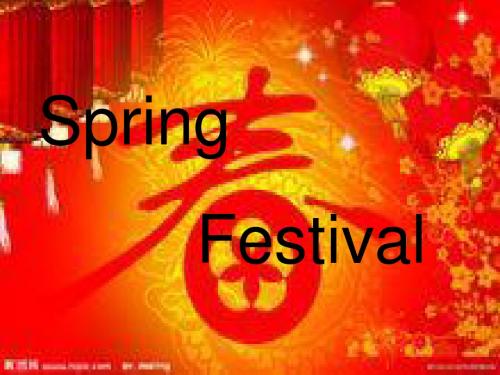
New Year's Visit and Gift Money
On the first day of the Chinese lunar year, everybody puts on their best clothes and pays ceremonial calls on their relatives and friends, wishing them all the luck in the coming year
Байду номын сангаас
Staying Up Late on New Year's Eve
on every New Year’s Eve, every household would have supper together. After dinner, no one dared go to sleep and all the family members would sit together, chatting and emboldening each other. Gradually the habit of staying up late on New Year’s Eve is formed.
Traditional Festival Greetings
恭贺新禧 Happy New Year
吉祥如意 Everything Goes Well 恭喜发财 Wishing You Prosperity
年年有余 Surplus Year after Year
岁岁平安 Peace All Year Round
Pasting Paper-cuts and “Upsided Fu”
Paper-cuts, usually with auspicious patterns, give a happy and prosperous atmosphere of the Festival and express the good wishes of Chinese people looking forward to a good life
The Introduction of Spring Festival春节简介
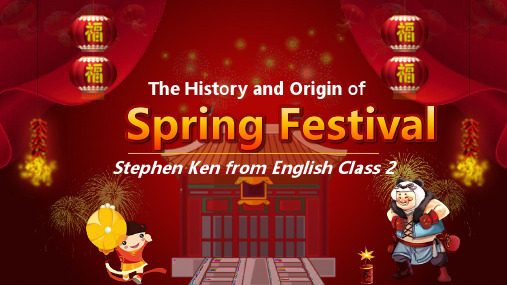
1 History of Spring Festival
Ploughing growth harvest storage
Spring Summer Autumn Winner
Spring cultivation, summer growth, autumn harvest, winter storage.
1 History of Spring Festival
the villagers gathered to discuss how to deal with” Nian”
some people suggested that the demon was afraid of loud noises, red color and flame
The History and Origin of
Stephen Ken from English Class 2
01 02
History Customs
03
Food
04
Words
1 History Of Spring Festival
1 History of Spring Festival
falls on in late January or early February
2 Customs of Spring Festival
Red couplets-red posters with black Chinese calligraphy, colored New Year paintings are posted on the doors of people’s houses.
2 Customs of Spring Festival
Some people even invert the character “fu” to signify that blessing has arrived because “inverted” is a homonym for “arrive” in Chinese.
春节的历史和由来英语作文
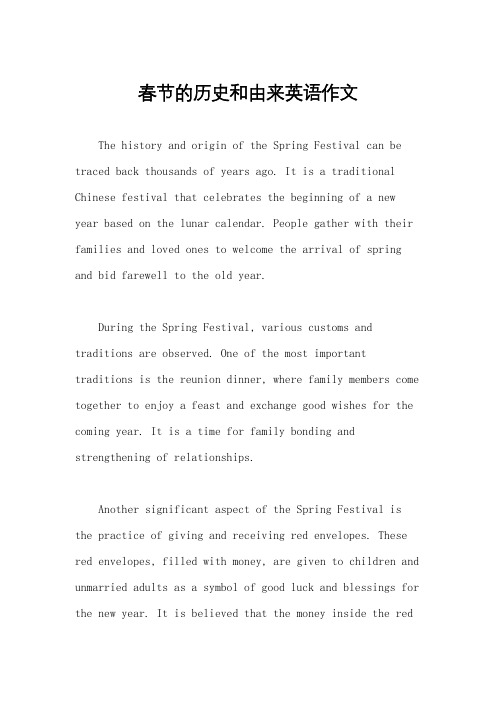
春节的历史和由来英语作文The history and origin of the Spring Festival can be traced back thousands of years ago. It is a traditional Chinese festival that celebrates the beginning of a new year based on the lunar calendar. People gather with their families and loved ones to welcome the arrival of spring and bid farewell to the old year.During the Spring Festival, various customs and traditions are observed. One of the most important traditions is the reunion dinner, where family members come together to enjoy a feast and exchange good wishes for the coming year. It is a time for family bonding and strengthening of relationships.Another significant aspect of the Spring Festival is the practice of giving and receiving red envelopes. These red envelopes, filled with money, are given to children and unmarried adults as a symbol of good luck and blessings for the new year. It is believed that the money inside the redenvelope will bring prosperity and happiness.Fireworks are also a common sight during the Spring Festival. The loud noises and bright lights are believed to scare away evil spirits and bring good fortune for the year ahead. It is a time for celebration and joy, with people gathering in public squares to watch the spectacular fireworks display.In addition to these customs, the Spring Festival is also a time for cultural performances and traditional activities. Lion and dragon dances are performed in the streets, accompanied by the rhythmic beats of drums and cymbals. These dances are believed to bring good luck and drive away evil spirits.Overall, the Spring Festival is a time of joy, celebration, and renewal. It is a time for families to come together, for communities to bond, and for people to express their hopes and wishes for the new year. It is a festival that embodies the rich cultural heritage of China and holds deep significance for the Chinese people.。
一个中国的重要节日英语作文起源和重要性
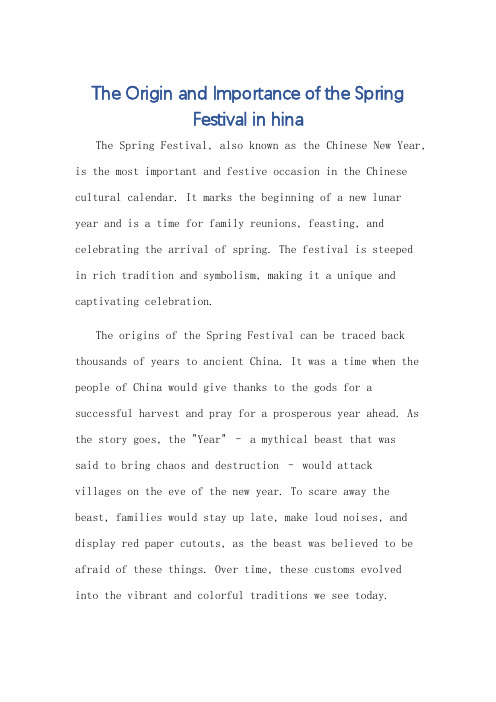
The Origin and Importance of the SpringFestival in hinaThe Spring Festival, also known as the Chinese New Year, is the most important and festive occasion in the Chinese cultural calendar. It marks the beginning of a new lunar year and is a time for family reunions, feasting, and celebrating the arrival of spring. The festival is steepedin rich tradition and symbolism, making it a unique and captivating celebration.The origins of the Spring Festival can be traced back thousands of years to ancient China. It was a time when the people of China would give thanks to the gods for a successful harvest and pray for a prosperous year ahead. As the story goes, the "Year" – a mythical beast that wassaid to bring chaos and destruction – would attackvillages on the eve of the new year. To scare away the beast, families would stay up late, make loud noises, and display red paper cutouts, as the beast was believed to be afraid of these things. Over time, these customs evolvedinto the vibrant and colorful traditions we see today.The importance of the Spring Festival in Chineseculture cannot be overstated. It is not just a time for feasting and merriment, but also a time for reflection and renewal. It is a chance for families to gather together, regardless of where they may be in the world, and celebrate the bonds of kinship and the promise of a new year. The festival is also a time for giving red envelopes (hongbao) as a symbol of good luck and prosperity. These envelopes are usually given to children and unmarried individuals, and are considered a lucky omen for the recipient.The celebrations of the Spring Festival are rich in tradition and仪式. Homes are装饰with red paper cutouts, couplets, and lanterns, as red is considered a lucky color that brings good fortune. Families prepare a special reunion dinner, known as "Nian Ye Fan," which usually consists of dishes that symbolize prosperity, health, and longevity. Fireworks and lanterns light up the sky, bringing joy and excitement to the atmosphere.The Spring Festival is not just a national holiday in China, but a cultural phenomenon that is celebrated by Chinese people worldwide. It is a testament to theresilience and enduring spirit of Chinese culture, and a reminder of the importance of family, tradition, and community. As the world becomes increasingly interconnected, the influence of the Spring Festival is spreading, introducing more people to the rich tapestry of Chinese culture and tradition.In conclusion, the Spring Festival is a festive and important occasion in Chinese culture that marks the beginning of a new year. It is a time for family reunions, feasting, and celebrating the arrival of spring. Thefestival is steeped in rich tradition and symbolism, making it a unique and captivating celebration that is not just limited to China, but is also celebrated by Chinese people worldwide. The importance of the Spring Festival lies inits ability to bring people together, to promote family values, and to preserve and honor the rich culturalheritage of China.中国春节的起源与重要性春节,也被称为中国新年,是中国文化日历中最重要、最欢乐的节日。
春节历史作文英语版
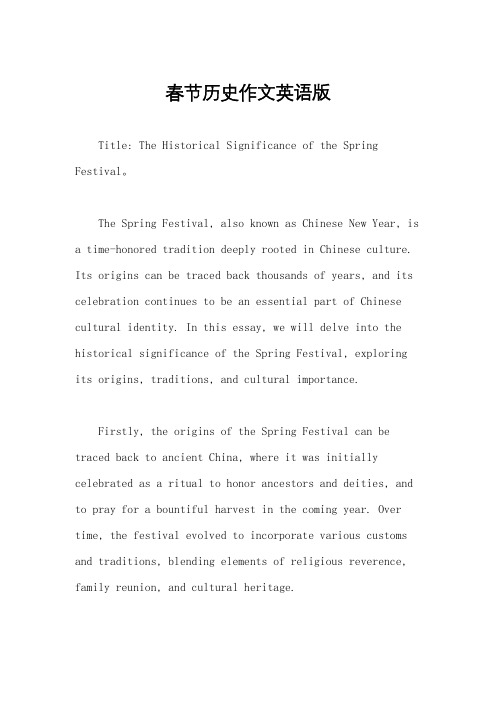
春节历史作文英语版Title: The Historical Significance of the Spring Festival。
The Spring Festival, also known as Chinese New Year, is a time-honored tradition deeply rooted in Chinese culture. Its origins can be traced back thousands of years, and its celebration continues to be an essential part of Chinese cultural identity. In this essay, we will delve into the historical significance of the Spring Festival, exploring its origins, traditions, and cultural importance.Firstly, the origins of the Spring Festival can be traced back to ancient China, where it was initially celebrated as a ritual to honor ancestors and deities, and to pray for a bountiful harvest in the coming year. Over time, the festival evolved to incorporate various customs and traditions, blending elements of religious reverence, family reunion, and cultural heritage.One of the most iconic traditions associated with the Spring Festival is the practice of setting off fireworksand firecrackers. This tradition has its roots in ancient legends and beliefs. According to folklore, the loud noiseof fireworks and firecrackers was believed to scare awayevil spirits and bad luck, ensuring a prosperous and auspicious start to the new year.Another essential aspect of the Spring Festival is the reunion dinner, known as "Nian Ye Fan." Families gather together on the eve of the new year to enjoy a lavish feast, symbolizing unity, harmony, and abundance. It is a time for family members to reconnect, reminisce about the past year, and look forward to the opportunities and challenges of the year ahead.The Spring Festival also involves various customs and rituals designed to bring good luck and fortune. For example, the tradition of giving out red envelopes, or "hongbao," containing money is believed to bring blessings and prosperity to both the giver and the receiver. Additionally, the decoration of homes with red lanterns,couplets, and other auspicious symbols is thought to ward off evil spirits and attract good fortune.Moreover, the Spring Festival is a time for cultural expression and artistic performances. Throughout the holiday season, communities organize colorful parades, dragon dances, and lion dances to celebrate the festive atmosphere and showcase traditional Chinese culture to the world.Beyond its cultural significance, the Spring Festival holds broader social and economic implications. It is the largest annual migration in the world, as millions of people travel across the country to reunite with their families. This mass movement of people, known as the Spring Festival travel rush or "Chunyun," reflects the deep-seated importance of family and kinship in Chinese society.Furthermore, the Spring Festival plays a crucial rolein stimulating economic activity. It is a peak period for consumer spending, as people purchase gifts, new clothes, and festive decorations to prepare for the celebrations.Additionally, businesses across various sectors, such as transportation, hospitality, and retail, experience a surge in demand during this time.In conclusion, the Spring Festival is not merely a time of revelry and merriment but a rich tapestry of history, tradition, and cultural heritage. Its origins can be traced back to ancient rituals and beliefs, and its celebration continues to be a cornerstone of Chinese cultural identity. As we usher in each new year, the Spring Festival serves as a reminder of the enduring values of family, community, and prosperity that unite us all.。
中国传统节日的由来英语作文
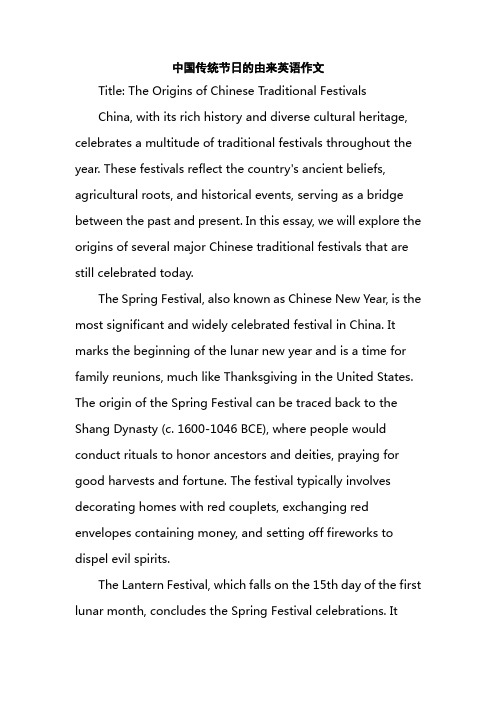
中国传统节日的由来英语作文Title: The Origins of Chinese Traditional FestivalsChina, with its rich history and diverse cultural heritage, celebrates a multitude of traditional festivals throughout the year. These festivals reflect the country's ancient beliefs, agricultural roots, and historical events, serving as a bridge between the past and present. In this essay, we will explore the origins of several major Chinese traditional festivals that are still celebrated today.The Spring Festival, also known as Chinese New Year, is the most significant and widely celebrated festival in China. It marks the beginning of the lunar new year and is a time for family reunions, much like Thanksgiving in the United States. The origin of the Spring Festival can be traced back to the Shang Dynasty (c. 1600-1046 BCE), where people would conduct rituals to honor ancestors and deities, praying for good harvests and fortune. The festival typically involves decorating homes with red couplets, exchanging red envelopes containing money, and setting off fireworks to dispel evil spirits.The Lantern Festival, which falls on the 15th day of the first lunar month, concludes the Spring Festival celebrations. Itoriginated during the Han Dynasty (206 BCE-220 CE) as a way for Emperor Wen of Han to honor a temple attendant who helped him ascend to the throne. The festival is marked by lighting and carrying colorful lanterns, solving riddles written on lanterns, and eating sticky rice dumplings called tangyuan, symbolizing unity and completeness.The Qingming Festival, or Tomb-Sweeping Day, is observed on the 15th day after the spring equinox, usually around early April. It is a day for paying respects to ancestors and deceased loved ones by visiting their graves, cleaning the tombstones, and making offerings. The custom has its roots in the Zhou Dynasty (c. 1046-256 BCE) but became popularized during the Tang Dynasty (618-907 CE). The festival also signifies the beginning of the warm season and the time for sowing seeds.The Dragon Boat Festival, or Duanwu Festival, takes place on the fifth day of the fifth lunar month, which usually falls in June. It commemorates the death of the poet Qu Yuan, an ancient patriot who drowned himself in protest against corruption during the Warring States period (475-221 BCE). The festival is characterized by dragon boat races and eating zongzi, sticky rice wrapped in bamboo leaves, which representthe rice offerings thrown into the river to protect Qu Yuan from evil creatures.The Mid-Autumn Festival, celebrated on the 15th day of the eighth lunar month, typically in September, is associated with the legend of Chang'e, the moon goddess. According to the legend, after consuming an elixir of immortality, Chang'e flew to the moon and lived there alone. The festival is a time for family gatherings, admiring the full moon, and eating mooncakes, which symbolize reunion and harmony.In conclusion, these traditional festivals are not just mere holidays but are deeply rooted in Chinese culture and history. They provide insights into the values, beliefs, and way of life of the Chinese people. As such, they continue to be celebrated with great enthusiasm and reverence, passing down traditions and connecting the Chinese people to their rich cultural past.。
春节虎年的来历作文英语
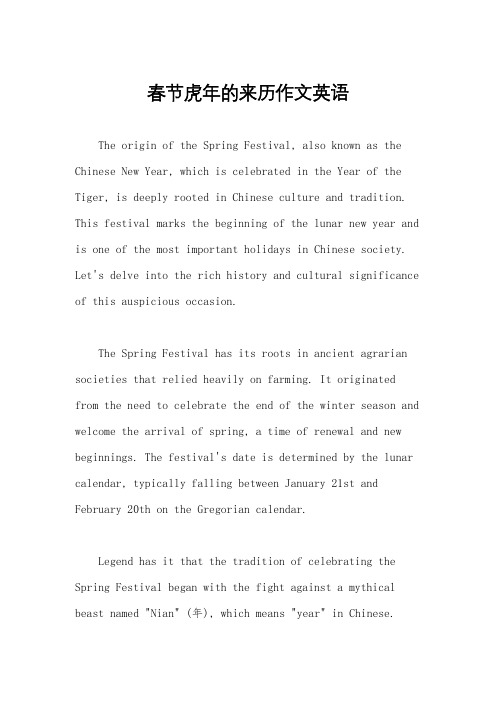
春节虎年的来历作文英语The origin of the Spring Festival, also known as the Chinese New Year, which is celebrated in the Year of the Tiger, is deeply rooted in Chinese culture and tradition. This festival marks the beginning of the lunar new year and is one of the most important holidays in Chinese society. Let's delve into the rich history and cultural significance of this auspicious occasion.The Spring Festival has its roots in ancient agrarian societies that relied heavily on farming. It originated from the need to celebrate the end of the winter season and welcome the arrival of spring, a time of renewal and new beginnings. The festival's date is determined by the lunar calendar, typically falling between January 21st and February 20th on the Gregorian calendar.Legend has it that the tradition of celebrating the Spring Festival began with the fight against a mythical beast named "Nian" (年), which means "year" in Chinese.According to folklore, Nian would come down from the mountains on the eve of the new year to devour livestock, crops, and even villagers, especially children. To fend off Nian's attacks, the people learned that loud noises, bright lights, and the color red could scare the beast away. This led to the customs of setting off fireworks, hanging lanterns, and displaying red decorations during the Spring Festival.Another legend associated with the Spring Festival involves the tale of the Kitchen God. According to tradition, the Kitchen God, also known as Zao Jun, is believed to watch over each household throughout the year. On the 23rd day of the 12th lunar month, families offer sacrifices to the Kitchen God to ensure his favorable report to the Jade Emperor, the ruler of heaven, abouttheir household's behavior. This ritual is believed to ensure good fortune for the family in the coming year.As the Spring Festival approaches, families engage in thorough cleaning of their homes, known as "spring cleaning," to sweep away any ill fortune and make way forgood luck to enter. They also prepare festive dishes and special foods with symbolic meanings, such as fish for prosperity, dumplings for wealth, and sticky rice cakes for a higher income or position in the new year.One of the most anticipated customs of the Spring Festival is the reunion dinner on the eve of the lunar new year. Family members from near and far come together to enjoy a lavish feast, exchange gifts, and share stories of the past year. This tradition underscores the importance of family and filial piety in Chinese culture.During the Spring Festival, people also participate in various cultural activities and performances, such asdragon and lion dances, traditional opera, and temple fairs. These festivities add to the vibrant atmosphere of the holiday and strengthen community bonds.In modern times, the Spring Festival has evolved into a time of mass migration, with millions of people traveling across the country to reunite with their families. This massive movement of people, known as the Spring Festivaltravel rush or "chunyun," is considered the largest annual human migration in the world.Overall, the Spring Festival in the Year of the Tigeris a time-honored tradition that celebrates Chinese culture, heritage, and values. It serves as a reminder of the importance of family, unity, and the hope for a prosperous future. As we usher in the new year, let us embrace thespirit of the tiger with courage, strength, and resilience.。
春节起源英语版范文
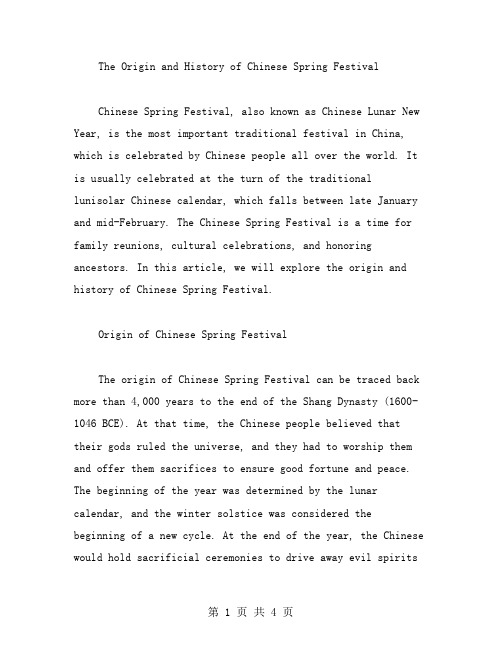
The Origin and History of Chinese Spring FestivalChinese Spring Festival, also known as Chinese Lunar New Year, is the most important traditional festival in China, which is celebrated by Chinese people all over the world. It is usually celebrated at the turn of the traditionallunisolar Chinese calendar, which falls between late January and mid-February. The Chinese Spring Festival is a time for family reunions, cultural celebrations, and honoring ancestors. In this article, we will explore the origin and history of Chinese Spring Festival.Origin of Chinese Spring FestivalThe origin of Chinese Spring Festival can be traced back more than 4,000 years to the end of the Shang Dynasty (1600-1046 BCE). At that time, the Chinese people believed that their gods ruled the universe, and they had to worship them and offer them sacrifices to ensure good fortune and peace. The beginning of the year was determined by the lunar calendar, and the winter solstice was considered the beginning of a new cycle. At the end of the year, the Chinese would hold sacrificial ceremonies to drive away evil spiritsand welcome the New Year. This ceremony is the early form of the Chinese Spring Festival.History of Chinese Spring FestivalDuring the Qin Dynasty (221-206 BCE), the Chinese began to hold an annual celebration on the first day of the lunar new year to welcome the gods and honor ancestors. This practice was passed down through the Han Dynasty (202 BCE-220 CE) and Tang Dynasty (618-907 CE). It was during the Tang Dynasty that the Chinese Spring Festival became a national holiday and a time for family reunions. The first day of the lunar new year was designated as the "Spring Festival" and began a fifteen-day celebration with each day having its own special meaning.In the Ming Dynasty (1368-1644 CE), the Chinese Spring Festival became more colorful and diversified. The popular folk custom of Chinese New Year's paintings, window paper-cuts, dragon and lion dances, and fireworks all became popular during that period. In addition, the Chinese also began to prepare special foods for the Spring Festival, such as dumplings, rice cakes, and New Year's cakes.During the Qing Dynasty (1644-1912 CE), the Chinese Spring Festival became a grand event with many cultural activities, such as the imperial court ceremony, the Qingming Festival, and temple fairs. The Qingming Festival marked the time for the Chinese to pay respect to their ancestors. Temple fairs were also held during the Spring Festival, which offered people a chance to enjoy cultural performances, purchase goods, and play games.Revival of Chinese Spring FestivalAfter the founding of the People's Republic of China in 1949, the Spring Festival took on a new look and became a public holiday. However, it wasn't until the reform and opening up policy in the late 1970s that the Chinese Spring Festival began to revive its traditional customs and culture. With the development of the economy and society, the Spring Festival has become a major event for Chinese people to return to their hometowns, visit relatives and friends, and enjoy the customs and traditions of the festival.ConclusionThroughout China's long history, the Chinese Spring Festival has been an important event that reflects theculture and traditions of the Chinese people. It is a timefor family reunions, cultural celebrations, and honoring ancestors. The Chinese Spring Festival has survived for over 4,000 years and is still thriving today. It not only reflects the Chinese people's respect for their customs and traditions, but also shows the vitality of their traditional culture. The Chinese Spring Festival, as a symbol of Chinese culture, is a valuable heritage that should be passed on from generation to generation.。
春节起源英文作文
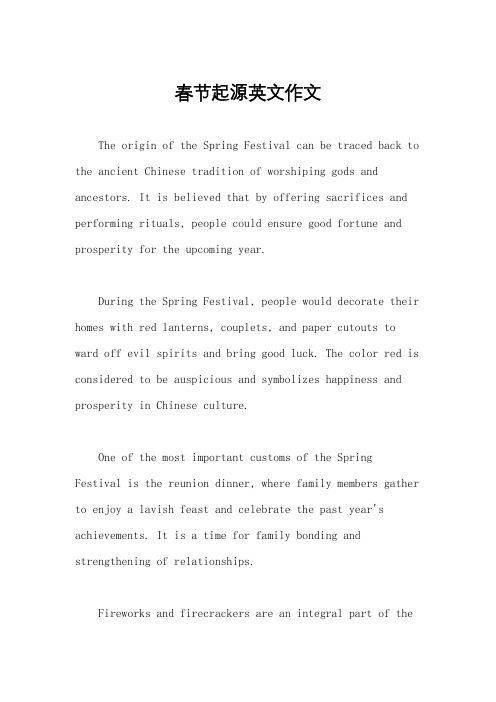
春节起源英文作文The origin of the Spring Festival can be traced back to the ancient Chinese tradition of worshiping gods and ancestors. It is believed that by offering sacrifices and performing rituals, people could ensure good fortune and prosperity for the upcoming year.During the Spring Festival, people would decorate their homes with red lanterns, couplets, and paper cutouts to ward off evil spirits and bring good luck. The color red is considered to be auspicious and symbolizes happiness and prosperity in Chinese culture.One of the most important customs of the SpringFestival is the reunion dinner, where family members gather to enjoy a lavish feast and celebrate the past year's achievements. It is a time for family bonding and strengthening of relationships.Fireworks and firecrackers are an integral part of theSpring Festival celebrations, as they are believed to scare away evil spirits and bring good luck. The loud noises and bright lights are also a way to welcome the New Year with joy and excitement.The tradition of giving red envelopes filled with money to children and unmarried adults is a way to share blessings and good fortune. It is also a gesture of well-wishing for the recipients to have a prosperous and successful year ahead.The Spring Festival is a time for people to pay respects to their ancestors by visiting their graves and offering prayers and offerings. It is a way to honor the past and seek blessings for the future.The lion and dragon dances are traditional performances that are believed to bring good luck and prosperity. The vibrant and energetic dances are accompanied by the rhythmic beats of drums and cymbals, creating a festive atmosphere.The Spring Festival is a time for people to clean and decorate their homes, as it is believed to sweep away bad luck and make room for good fortune to enter. It is also a way to welcome the New Year with a fresh start and positive energy.The practice of wearing new clothes during the Spring Festival is a way to symbolize new beginnings and a fresh start. It is also a way to show respect for the occasion and to present oneself in the best possible manner.。
春节的来历与习俗英语作文
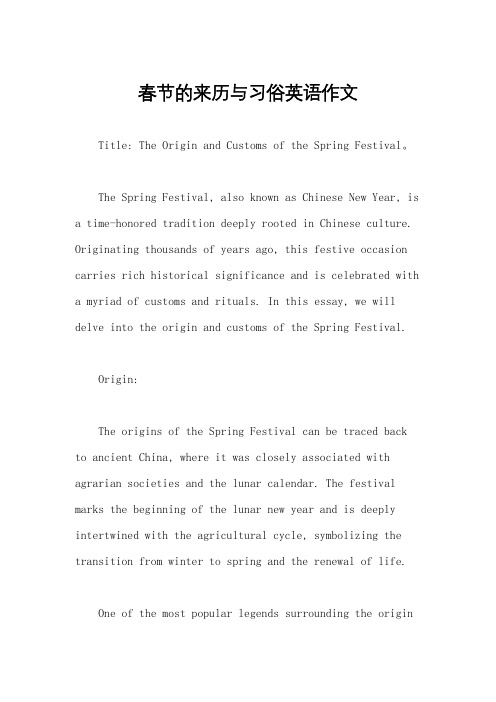
春节的来历与习俗英语作文Title: The Origin and Customs of the Spring Festival。
The Spring Festival, also known as Chinese New Year, is a time-honored tradition deeply rooted in Chinese culture. Originating thousands of years ago, this festive occasion carries rich historical significance and is celebrated with a myriad of customs and rituals. In this essay, we will delve into the origin and customs of the Spring Festival.Origin:The origins of the Spring Festival can be traced back to ancient China, where it was closely associated with agrarian societies and the lunar calendar. The festival marks the beginning of the lunar new year and is deeply intertwined with the agricultural cycle, symbolizing the transition from winter to spring and the renewal of life.One of the most popular legends surrounding the originof the Spring Festival is the story of Nian, a mythical beast that would emerge on the eve of the new year todevour crops, livestock, and even people. To ward offNian's evil presence, ancient Chinese people would hang red lanterns, set off firecrackers, and paste red couplets on their doors. These customs eventually evolved into the festive traditions we observe today.Customs and Traditions:1. Reunion Dinner: The Spring Festival is a time for families to come together and celebrate. The reunion dinner, held on the eve of the new year, is perhaps the most important meal of the year. Families gather around thetable to enjoy lavish feasts featuring traditional dishes such as fish, dumplings, and longevity noodles.2. Red Decorations: The color red plays a prominentrole in Spring Festival decorations. Red is believed to symbolize good fortune, happiness, and prosperity. Homesare adorned with red lanterns, red paper cutouts, and red couplets。
中国春节英文介绍
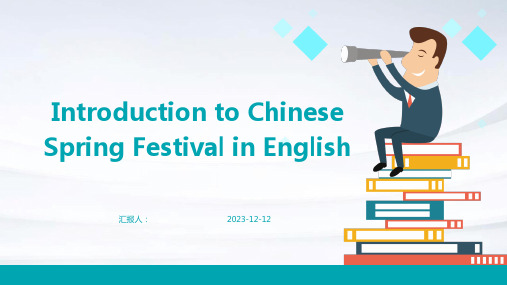
汇报人:
2023-12-12
目录
Contents
• Introduction to Spring Festiva • Celebration activities for the • The customs and conditions
Family cancellation activities
01 02
Preparing Reunion Diner
Preparing a Delicious Reunion Diner is an essential part of the Spring Festival Chinese people attach great importance to this traditional festival and will prepare the most delicious dishes to celebrate it
The origin of the Spring Festival is believed to be traced back to
the Xia Dynasty, which was over 4000 years ago
02 03
Legendary origin
According to legend, the festival got its start when a Monster called "Nian" was driven away by a red paper cutout of a child named "Fu"
The Tradition of Spring Festival
中国春节英语

03
In ambient times, people believed that the dragon and lion had the function of warding off evil spirits, so they used dragon and lion dance performances to pray for peace and good luck
Temple fair activities during
• Gradually, the simple fair is because of an important part of the Spring Festival
Temple fair activities during
2. Activities at activities during
3. Significance of sample fairs
The sample fair is an important part of the Spring Festival, which is a traditional cultural festival for Chinese people
• In the Song Dynasty, the Spring Festival was called "Festival of the First Moon" During this period, the Spring Festival was a grand festival with many customs People would go to samples to pray for good luck, wear red paper cutouts and couples with popular themes such as "good fortune, happiness, peace and joy"
春节历史作文英语
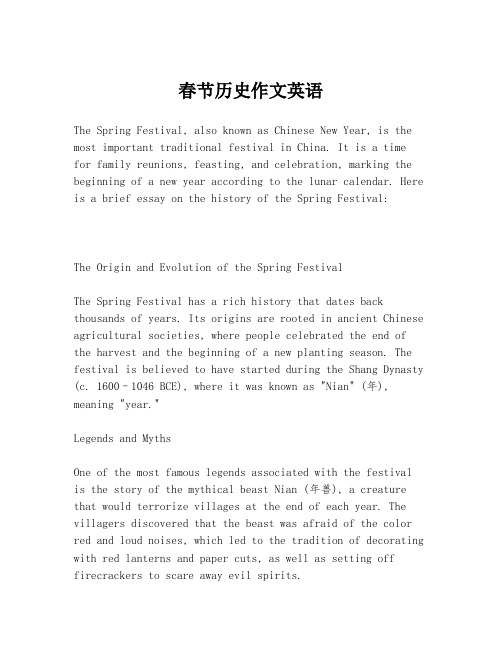
春节历史作文英语The Spring Festival, also known as Chinese New Year, is the most important traditional festival in China. It is a timefor family reunions, feasting, and celebration, marking the beginning of a new year according to the lunar calendar. Here is a brief essay on the history of the Spring Festival:The Origin and Evolution of the Spring FestivalThe Spring Festival has a rich history that dates back thousands of years. Its origins are rooted in ancient Chinese agricultural societies, where people celebrated the end of the harvest and the beginning of a new planting season. The festival is believed to have started during the Shang Dynasty (c. 1600–1046 BCE), where it was known as "Nian" (年), meaning "year."Legends and MythsOne of the most famous legends associated with the festivalis the story of the mythical beast Nian (年兽), a creature that would terrorize villages at the end of each year. The villagers discovered that the beast was afraid of the color red and loud noises, which led to the tradition of decorating with red lanterns and paper cuts, as well as setting off firecrackers to scare away evil spirits.Cultural SignificanceOver time, the Spring Festival has evolved into a celebration that encompasses a variety of cultural practices. Thefestival is a time for family members to come together, often traveling long distances to be with their loved ones. It is customary to clean the house thoroughly before the festival to sweep away bad luck and make room for incoming good fortune.Traditions and CustomsThe Spring Festival is marked by a series of traditional customs. The most iconic is the family reunion dinner on New Year's Eve, where a feast is prepared with dishes that symbolize prosperity, such as fish (余, yú), which sounds like "surplus" in Chinese, and dumplings (饺子, jiǎozi), which resemble ancient Chinese gold ingots. Another important tradition is the giving of red envelopes (红包, hóngbāo) containing money to children and unmarried adults, symbolizing the transfer of luck and blessings.Modern CelebrationsIn the modern era, the Spring Festival has expanded beyond China to include celebrations in many parts of the world where Chinese communities reside. Parades, performances, and cultural events are held to celebrate the festival,attracting both Chinese and non-Chinese participants.ConclusionThe Spring Festival is more than just a holiday; it is a reflection of Chinese culture and history. It is a time for joy, reflection, and hope for the future. As the festival continues to evolve, it remains a cherished time for millions around the world, a testament to the enduring spirit and traditions of the Chinese people.This essay provides a concise overview of the SpringFestival's history, significance, and traditions, offering insights into the rich cultural tapestry of China.。
春节的由来英语作文
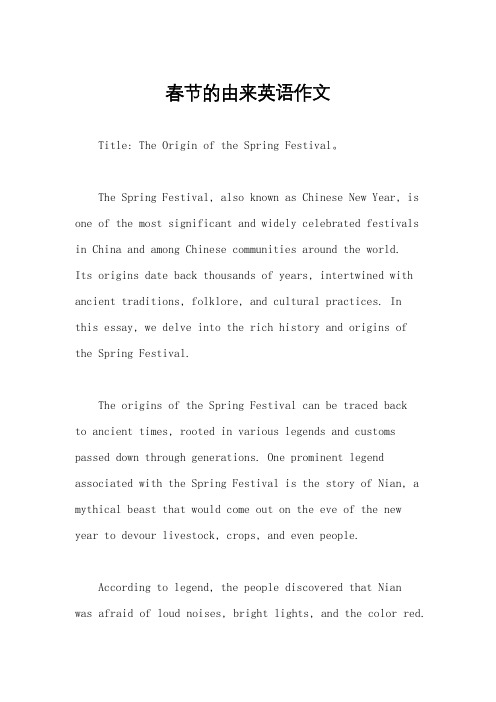
春节的由来英语作文Title: The Origin of the Spring Festival。
The Spring Festival, also known as Chinese New Year, is one of the most significant and widely celebrated festivals in China and among Chinese communities around the world.Its origins date back thousands of years, intertwined with ancient traditions, folklore, and cultural practices. Inthis essay, we delve into the rich history and origins of the Spring Festival.The origins of the Spring Festival can be traced backto ancient times, rooted in various legends and customs passed down through generations. One prominent legend associated with the Spring Festival is the story of Nian, a mythical beast that would come out on the eve of the new year to devour livestock, crops, and even people.According to legend, the people discovered that Nianwas afraid of loud noises, bright lights, and the color red.To ward off the beast, they would hang red lanterns, setoff firecrackers, and decorate their homes with red paper cutouts. This tradition eventually evolved into the festive atmosphere we see during the Spring Festival today, characterized by vibrant red decorations, fireworks, and lantern displays.Another legend linked to the Spring Festival is thetale of the Kitchen God. According to tradition, the Kitchen God, or Zao Jun, is believed to watch over the household and report the family's behavior to the Jade Emperor in heaven. To ensure a favorable report, families offer sacrifices to the Kitchen God before the new year, hoping for prosperity and good fortune in the coming year.The Spring Festival is also deeply rooted in agrarian culture, marking the end of winter and the beginning of spring. It is a time for families to gather, pay respects to ancestors, and celebrate the arrival of a new year with feasts and festivities. Traditional customs include cleaning the house to sweep away bad luck, preparing special dishes like dumplings and fish symbolizingprosperity, and exchanging red envelopes containing money as a symbol of good luck and blessings.Throughout history, the Spring Festival has undergone various changes and adaptations, reflecting the cultural diversity and evolution of Chinese society. It has also become a time for cultural exchange and celebration, attracting people from all over the world to join in the festivities and experience the rich heritage of Chinese culture.In conclusion, the Spring Festival is a time-honored tradition that embodies the spirit of renewal, reunion, and hope for the future. Its origins are deeply rooted in ancient folklore, legends, and customs that have been passed down through generations. As we celebrate the Spring Festival each year, we not only pay homage to our ancestors and traditions but also embrace the opportunity to create new memories and experiences with our loved ones.。
- 1、下载文档前请自行甄别文档内容的完整性,平台不提供额外的编辑、内容补充、找答案等附加服务。
- 2、"仅部分预览"的文档,不可在线预览部分如存在完整性等问题,可反馈申请退款(可完整预览的文档不适用该条件!)。
- 3、如文档侵犯您的权益,请联系客服反馈,我们会尽快为您处理(人工客服工作时间:9:00-18:30)。
The History and Origin of Spring Festival(春节的历史与起源)
The Spring Festival, also known as the Lunar New Y ear, is the most important traditional festival in China, which falls on in late January or early February.
The historical reason for beginning the new year in such a time is that it is the time between autumn harvest and spring plowing and planning. In another words, it is the time for rest, relaxation and celebration after a year’s toil.
Except this practical reason for celebrating the Spring Festival, a popular Chinese legend offers another explanation, which is affectedly known in China.
In ancient time, a mythological demon called” Nian” that lived under the sea would plague people once a year on the even of the new year. It jumped out from the sea, attacked villages, devouring people, animals and plants.
Could no longer bear Nian’s brutal persecution, the villagers gathered to discuss how to deal with” Nian” and some people suggested that the demon was afraid of loud noises, red color and flame.
So people lighted firecrackers, put on red couplets on their gates, lit firework and beat gongs and drums to drive Nian away. The idea worked and Nian ran away.
Since ever, the custom and tradition of celebrating the Spring Festival born and the practice of putting red couplets on gates, setting off firecrackers, etc have been passed down.
How do Chinese people celebrate the Spring Festival
Spring Festival is a time for celebrating with family and friends. No matter wherever, how busy they are, the Chinese will squeeze into the roads going home to spend the festival season with their family members. Traditionally, the Chinese celebrate the Spring Festival in the following
ways:
Spring Cleaning: From December 23rd in the Chinese calendar, people begin to clean their houses to bid farewell to the old year and usher in a happy and fresh new year.
Spring Decorating: People hang flower-decorated red lanterns in front of their houses. Office buildings and stores are also decorated with red lanterns. Red couplets-red posters with black Chinese calligraphy, colored New Y ear paintings are posted on the doors of people’s houses. They symbolize happiness, prosperity and good luck in the New Y ear.。
